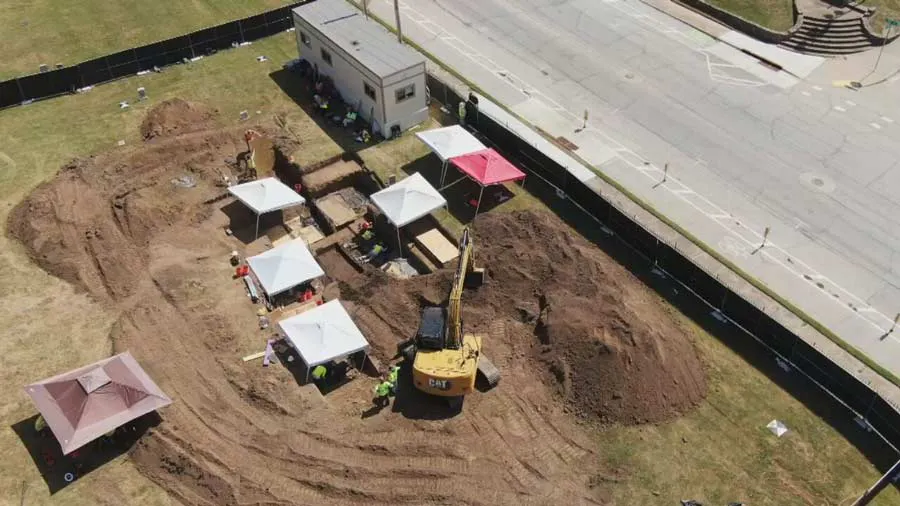4th Grave Exhumed At Oaklawn Cemetery In Search For 1921 Tulsa Race Massacre Victims
The team has parts of three rows dug out, running North and South, with 50 grave shafts discovered, and some now uncovered, underneath a row of tents along 11th Street. The search is underway in the Southwest corner of the cemetery, where black paupers were buried.Thursday, September 21st 2023, 6:54 pm
TULSA, Okla. -
A fourth grave was exhumed Thursday at Oaklawn Cemetery, where the City of Tulsa continues a search for victims of the 1921 Race Massacre.
The team has parts of three rows dug out, running North and South, with 50 grave shafts discovered, and some now uncovered, underneath a row of tents along 11th Street. The search is underway in the Southwest corner of the cemetery, where black paupers were buried.
“Even though there are not a substantial number of markers and formal headstones out here, we know by the work we've been doing here that there are many more graves out here than what we actually have good records to document,” State Archaeologist Dr. Kary Stackelbeck said.
During a test excavation, several bricks were discovered, standing on end, marking about half of the grave shafts that have now been identified.
As is the practice when a casket is exhumed, the team at Oaklawn wrapped it in a tarp, draped it with a Tulsa flag, and paused before walking it across to the onsite forensic lab. The work there is to identify the body is possible and determine if it’s possibly a victim of the massacre.
Wednesday, the team reported discovering a crate that was larger than a typical casket, but Dr. Stackelbeck said Thursday it was determined to be an oversized grave shaft with the casket of an adult and another for a child in the same spot. She said the work onsite would likely wrap up at the end of next week.
Previous Grave Shafts Found
Archaeologists found several more grave shafts at Oaklawn Cemetery, in the search for possible victims of the 1921 Tulsa Race Massacre.
They say they have exhumed one set of remains this week and are exhuming another today.
"We're expanding our block, and then we also have our teams who are continuing to make progress on the hand excavation on the graves we've already exposed previous to today," said Kary Stackelbeck.
Archaeologist Kary Stackelbeck says they have exposed 22 grave shafts that are about four and a half feet below the surface. They are exhuming two wooden caskets this week that will go straight to the on-site lab for forensic analysis.
Expanded Coverage: More Stories About The Oklahoma Race Massacre
"We had one exhumation yesterday, late afternoon, and then we have another one that is prepped and ready to go for a little bit later this afternoon as well," she said.
 She says they use death certificates and information from newspapers and funeral homes to determine where at the cemetery they should look.
She says they use death certificates and information from newspapers and funeral homes to determine where at the cemetery they should look.
"That information conveyed that we were looking for individuals who were adults, buried in simple wood caskets," she said.
While they've made progress in the search, Stackelbeck says they still have more to do.
"Part of this process as we go through this excavation work is to compile all of this information and look at it in relation to one another, to determine the extent in which those makeshift markers correlate with the graves that we are now encountering at that deeper depth," she said.
The group will be back at Oaklawn next week to continue the work.
Story Timeline: Archaeologists Find At Least 7 Grave Shafts So Far In Latest Excavation
Archaeologists looking for victims of the 1921 Tulsa Race Massacre at Oaklawn Cemetery found about 30 makeshift markers last week.
On Friday, September 8, The City of Tulsa said archaeologists found seven grave shafts and 3 partial grave shafts. Their focus is near the "Clyde Eddy" area. Eddy was 10 years old when he witnessed digging in this area of the cemetery and saw black victims in several wooden crates.
Related: Third Excavation In Oaklawn Starts In Ongoing Search For Race Massacre Victims
Archaeologists said they found 27 markers in four parallel rows and part of a fifth. Those markers include 16 bricks standing upright in the ground, 10 metal markers, and another made of stone.
Dr. Kary Stackelbeck said they are all placed about three feet apart.
“That’s what we’re in the process of doing today, is cutting our deeper trenches so that we can get down to a level and expose whether or not we have grave shafts directly in line that correlate with those markers,” she said.
Stackelbeck said while the team works, the late Kavin Ross is on everyone's mind. He served as the Chair of the Public Oversight Committee for the investigation and was on the ground, working side-by-side with archaeologists every step of the way.
“This latest location that we’re investigating now – we’re here in part because some of the information that he helped to provide to us that really helped us make a solid argument for why we felt like this was a good candidate for additional investigation,” Stackelbeck said. “So, and he has a legacy that just can’t be overstated.”
The rest of the team, including those who work in the forensic lab, will be in Tulsa next week. Scientists expect to be out here for the rest of the month.
More Like This
September 21st, 2023
July 12th, 2024
May 29th, 2024
Top Headlines
April 28th, 2025
April 28th, 2025
April 28th, 2025











